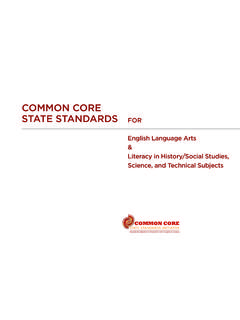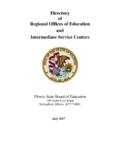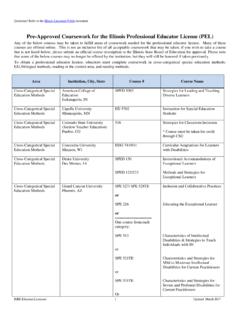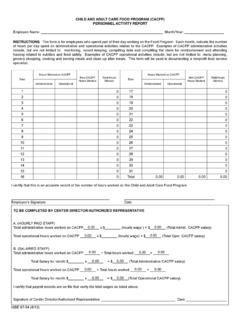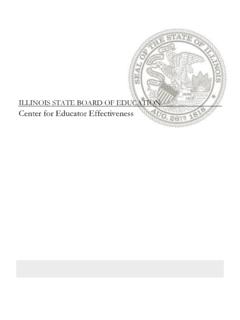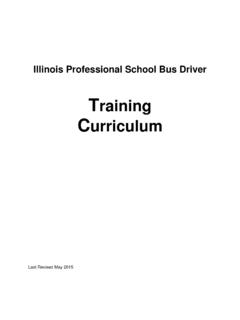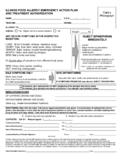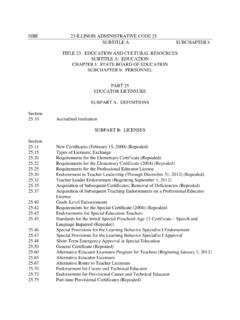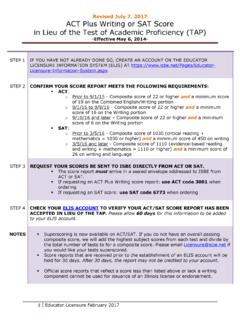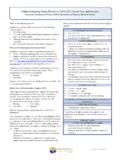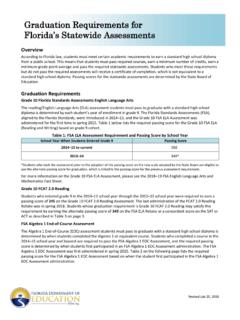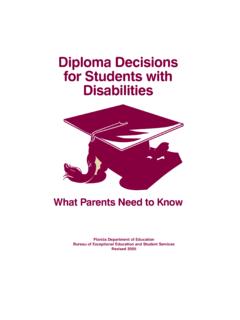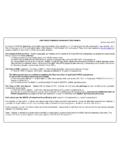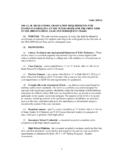Transcription of Illinois State Board of Education
1 1 Illinois State Board of Education State graduation requirements (105 ILCS 5/27-22, , ) February 2016 Guidance Document This document is intended to provide non-regulatory guidance on the subject matter listed above. For specific questions, please contact the division identified in the document. Illinois State Board of Education James T. Meeks, Chair Steven R. Gilford, Vice Chair Melinda A. LaBarre, Secretary Curt Bradshaw Lula Ford Craig Lindvahl Eligio Cerda Pimentel John W. Sanders Dr. Tony Smith, State Superintendent 2 graduation requirements : 105 ILCS 5/27-22, , The following information will help your school district offer the coursework necessary to meet the State graduation requirements . This document amends the September 2015 guidance to provide general updates resulting from recently enacted legislation and updates to agency rules.
2 Below is a summary of issues, presented in a question-and -answer format, that pertain to graduation requirements that may be of interest to school districts. 1. What are the State -imposed graduation requirements ? As you can see from the chart in Appendix A, the law has phased in the new graduation requirements over four years so that any student entering high school as a ninth-grader starting in the 2008-09 school year and beyond will have taken the following minimum number of courses during high school: 4 years of language arts; 2 years of writing-intensive courses, one year of which must be offered as an English language arts course and may be counted toward meeting one year of the four-year English language arts requirement. The writing courses may be counted toward the fulfillment of other State graduation requirements , when applicable, if writing-intensive content is provided in a subject area other than English language arts; 3 years of mathematics, one of which must be Algebra 1 and one of which must include geometry content; 2 years of science; 2 years of social studies, of which at least one year must be the history of the United states or a combination of the history of the United states and American government; and 1 year chosen from any of the following: o art; o music; o foreign language, which shall include American Sign Language; and o vocational Education .
3 Additionally, starting with students entering grade 9 in the 2016-17 school year and thereafter, at least one semester of civics coursework will be required. 2. What is the impact of Section of the School Code on the State graduation requirements listed above? Since 2005 when the new graduation requirements went into effect, the State Board of Education has heard concerns from parents and school officials about whether accelerated coursework completed by students in middle or junior high school particularly in the area of mathematics would need to be repeated in high school in order for it to count as meeting the State -imposed high school graduation requirements . Section to the School Code addresses these concerns by allowing school boards of high school or unit districts the option of adopting a policy to accept such courses under certain conditions specified in the law.
4 A student wishing to take the course must be enrolled in seventh or eighth grade. Either the student must take the course at the high school he or she would attend, and the elementary student s enrollment must not prevent a student enrolled in the high school from being able to take the course; or the student must take the course at the school the student attends provided that the course is taught by a teacher who holds a professional educator license under Article 21B of this Code that is endorsed for the grade level and content area of the course. The high school must grant academic credit, satisfying the State -imposed graduation requirements for that particular course, to an elementary student who successfully completes the course. The student s grade in the course must be included in his or her grade-point average in accordance with the Board s policy for making that calculation.
5 3 A school Board must award high school course credit and apply that credit towards meeting the State -imposed graduation requirements for any course a student transferring into the district has taken at another district, if the course was successfully completed in accordance with the requirements of Section of the School Code. The district may choose not to accept the course, however, if evidence of the course s rigor and content indicates it did not address the relevant Illinois Learning Standards at the level appropriate for the high school grade during which the course is usually taken. 3. The rules now distinguish between four-year high schools and three-year high schools. How do the graduation requirements affect three-year high schools? There only a few high schools in the State that serve only grades 10 through 12.
6 In order to receive a diploma , students in these schools will need to successfully complete the State -required coursework, whether at the three-year high school or during their ninth-grade experience in their middle schools. In schools with only grades 10 through 12, sufficient courses must be offered to ensure that all students can meet the State graduation requirements . The middle school that feeds into the high school must at least require all students in ninth grade to take an English language arts course to ensure that the four-year requirement is met by the end of students senior year. Only courses taken at the ninth-grade level in the middle schools that feed into a high school with grades 10 through 12 will be counted towards meeting State graduation requirements , although students in grades 7 or 8 may enroll in a high school course and have it count towards the State graduation requirements in accordance with the policy the district s school Board has adopted under Section of the School Code (see Question 2).
7 4. How does a district meet the writing-intensive requirement? What is a writing-intensive course? The writing-intensive requirement must be met through at least one, year-long English language arts course; the second year of writing intensive may be an English language arts course or may be included as part of another subject area. School districts need not count the writing-intensive course separately when determining if students meet the State graduation requirements . Rather, an English language arts course whose content primarily focuses on writing may be counted as meeting one of the four years of English required for graduation . When offered as part of another course required for graduation , such as science, social science or an elective, the course may be counted as both meeting the graduation requirement for writing and for meeting the specific requirement in that subject area.
8 In order to determine when a course other than English contains sufficient writing content to meet the writing-intensive graduation requirement, school districts should review administrative rules at 23 Ill. Adm. Code (d). These rules specify that the course description for a writing-intensive course will be accepted for purposes of Section 27-22 of the School Code if: a goal of the course is to use the writing that students do relative to the subject matter being presented as a vehicle for improving their writing skills; writing assignments will be an integral part of the course s content across the time span covered by the course; the written products students are required to prepare in order to receive credit for the course and the feedback students receive are such that: o students writing proficiency is evaluated against expectations that are appropriate to early or late high school and encompass all of the standards applicable to writing as set forth in the Illinois Learning Standards for English Language Arts incorporating the Common Core State Standards (see ); and o students receive information from the evaluation of their written products that will permit them to improve their writing skills in terms of correct usage; well-organized composition; communication of ideas for a variety of purposes; and locating, organizing, evaluating, and using information.
9 4 The writing-intensive study provided in at least one writing-intensive course must be designed to address and integrate the elements of the writing process and to refine or apply research skills. Generally, a writing-intensive course is one in which students are engaged for a significant portion of their class time in tasks focused on developing skills needed for them to become proficient and competent writers. For instance, the use of correct grammar, spelling, punctuation, capitalization and structure must be emphasized. students should be required to compose well-organized and coherent written products to be used for specific purposes and audiences. In addition, students should develop the ability to communicate ideas in a written format to accomplish a variety of purposes.
10 Additionally, writing-intensive courses may be used to teach students how to use a wide variety of information sources, including written products, to frame questions for inquiry, identify and organize relevant information, and communicate that information effectively in a variety of written formats. 5. Are there other regulatory criteria for mathematic courses? For instance, can the Algebra I course be offered over a period of two years? What percentage of the concepts of a math course that includes geometry must be included in the course in order for it to meet the graduation requirement of one year of geometry? In determining the content of Algebra I or geometry courses, districts should refer to standards specific to these two areas set forth in the Illinois Learning Standards for Mathematics incorporating the Common Core State Standards found at The State Board of Education determined that it did not need to develop additional standards to regulate the content of mathematics courses.
